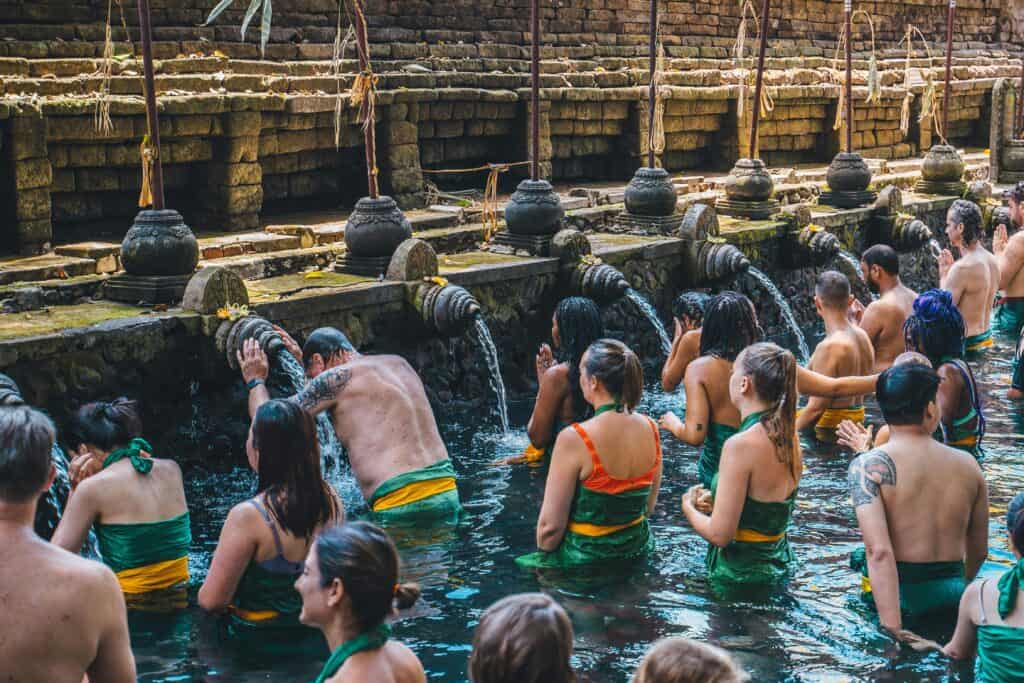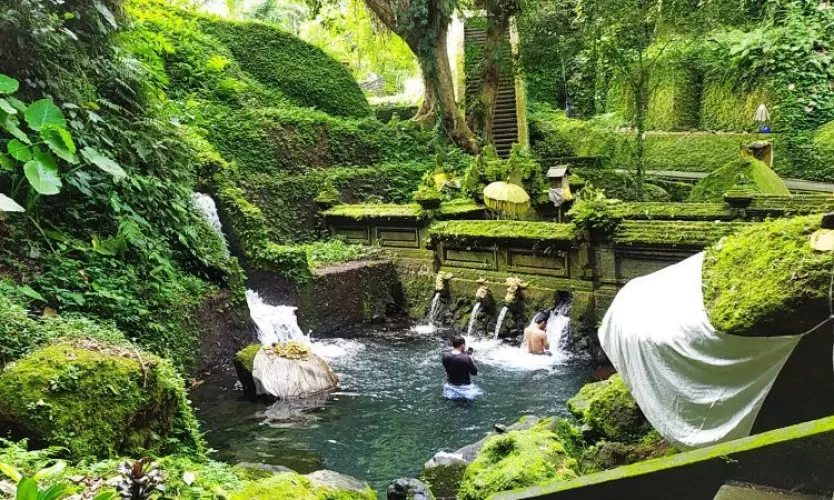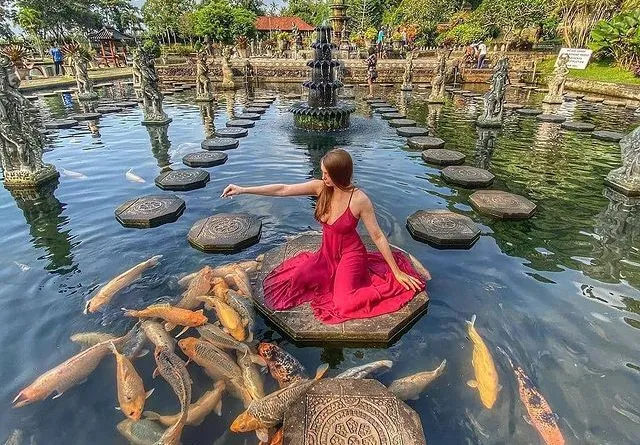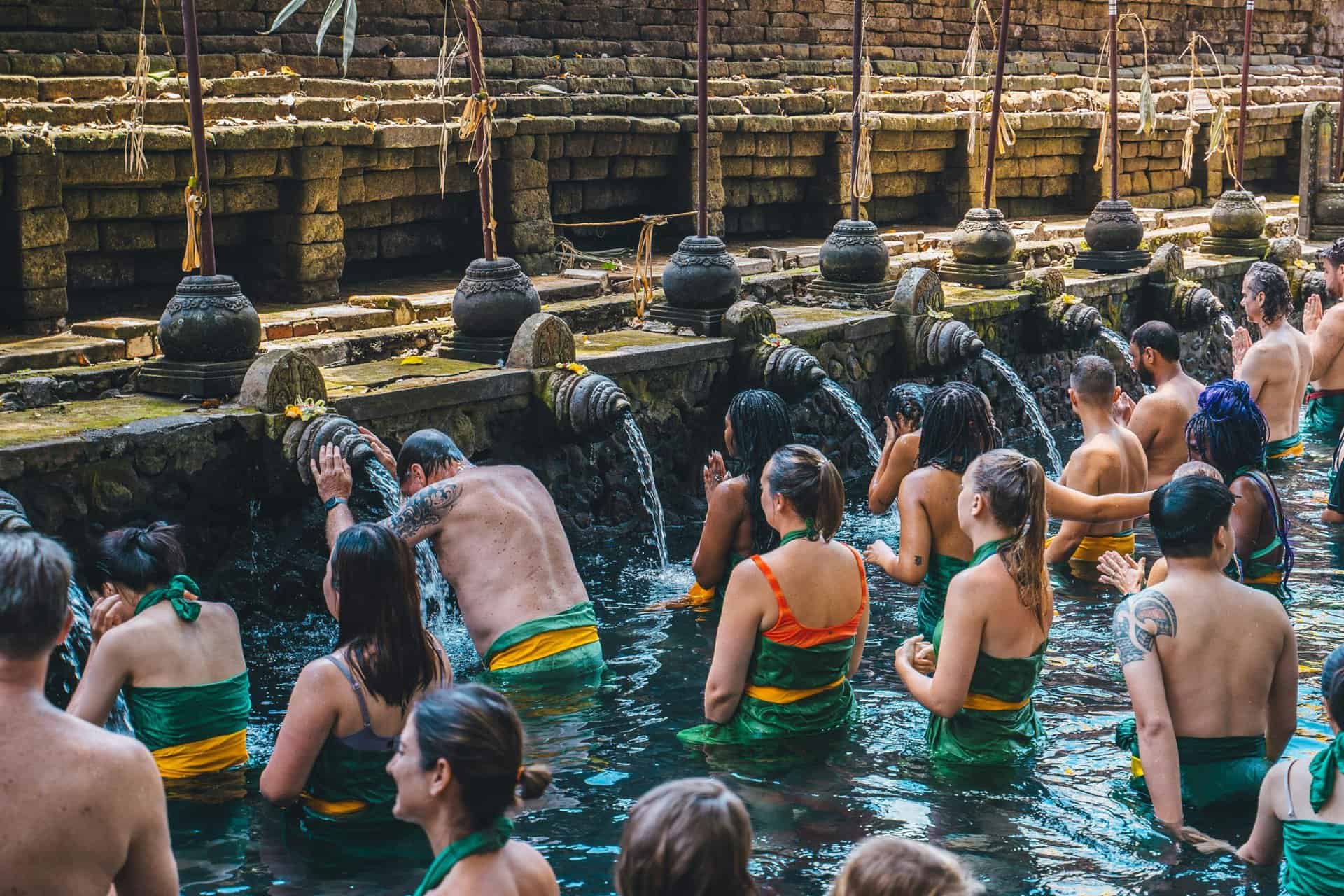In the past few months, we’ve witnessed a surge in tourists flocking to Bali, drawn not just by its stunning landscapes and vibrant culture, but also by the allure of its sacred waters—the Holy Springs. These natural wonders hold a special place in Balinese tradition, believed to possess profound spiritual energy and healing properties. In this guide, we’ll list all the famous Holy Springs in Bali you can visit, the detailed information such as the entrance fee and the regulations to enter these holy springs.
Tirta Empul: The Most Famous Holy Spring in Bali

Tirta Empul is one of Bali’s most famous holy springs and is located in the village of Tampaksiring. The temple complex features a large pool fed by a holy spring, where visitors can participate in a purification ritual known as melukat. This ritual involves immersing oneself in the holy water while reciting prayers and mantras, with the belief that it will cleanse the body, mind, and soul.
Quoting from the book “Jalan-Jalan Bali” by Agung Bawantara, the name Tirta Empul originates from the Balinese language, meaning holy spring. “Tirta” translates to “holy water” and “Empul” means “spring”. The water at Tirta Empul temple originates from the Pakerisan River.
The temple itself is a beautiful example of Balinese architecture, with intricate carvings and statues that depict scenes from Hindu mythology. The complex also features several other shrines and pavilions where visitors can pay their respects to the gods and goddesses.
Tirta Empul is not only a place of spiritual significance but also a popular tourist attraction. Visitors from all over the world come to experience the healing powers of the holy water and to witness the beauty of the temple complex. It is a place where one can find peace and tranquility amidst the hustle and bustle of Bali’s tourist hotspots.
Key Information
- Dress Code: Visitors entering the temple area must wear a sarong and a scarf around their waist. These are provided at the temple entrance gate and are included in the entrance fee. For women who are menstruating, entry into the temple area is not allowed.
- The entrance fee for Tirta Empul Temple, one of the most famous holy spring water temples in Bali, is IDR 50,000 rupiah per person
- Best Time to Visit: The best time to visit Tirta Empul is during the full moon or new moon (“Tilem”) when many local people come to worship. However, if you want to perform purification, it’s advisable to visit in the morning and avoid holidays or weekends.
- Opening Hours: Tirta Empul Temple is open every day from 07:00 to 17:00 for tourists.
- History: Tirta Empul Temple was created by the god Indra during the war against Mayanadenawa from Bedahulu Kingdom. King Maya Denawa’s greed led to the collapse of his kingdom, and Indra came to save the world from destruction caused by the king.
Pura Mengening: Tirta Empul Neighboor
If Tirta Empul is too crowded for you then you can go to the neighboor, Pura Mengening. Located in Saraseda, Tampaksiring, Bali, Pura Mengening bears resemblance to the renowned Tirta Empul Temple, both featuring holy water springs and renowned for Melukat ceremonies. While Tirta Empul traces its roots back to the 10th century, Pura Mengening was constructed in the 11th century.

Pura Mengening is just 3 minutes drive away from Tirta Empul, we always go there for Melukat if we found Tirta Empul getting crowded. Pura Mengening offers a serene atmosphere and attracts fewer tourists compared to Tirta Empul. For international tourists, the entrance fee is Rp30,000, which includes sarong rental.
Key Information
- Pura Mengening was built in the 11th century, while Tirta Empul dates back to the 10th century.
- Those interested in partaking in the Melukat ceremony can seek guidance from the temple staff. Pura Mengening is open daily from 9 AM to 5 PM, with weekdays being preferable to avoid crowds.
- Pura Mengening boasts 12 holy water springs (Tirtas), each serving a distinct purpose. Tirta Sudamala and Tirta Telaga Waja are used for Melukat rituals, while others like Tirta Dedari, Tirta Melea, and Tirta Angkosa are associated with beauty-related significance.
Tirta Gangga: A Picturesque Water Palace with Holy Springs
Tirta Gangga is a water palace located in Karangasem, Bali. The palace was built in the early 20th century by the royal family of Karangasem as a place of relaxation and recreation. It features several pools and fountains fed by holy springs, as well as beautiful gardens and architecture.
“Tirta Gangga,” translated as “Water from the Ganges” in Balinese, symbolizes the sacredness and purity linked with its waters. The River Ganges holds significant importance in Hindu tradition.

The palace is known for its intricate stone carvings and statues that depict scenes from Hindu mythology. Visitors can explore the palace’s picturesque setting, stroll through the gardens, and even take a dip in the holy waters.
Tirta Gangga is a popular tourist destination, offering a serene and peaceful environment for visitors to relax and rejuvenate. It is a place where one can escape the hustle and bustle of Bali’s tourist hotspots and immerse themselves in the beauty of nature.
Key Information
- The entrance fee for Tirta Gangga Water Palace in Bali, Indonesia is approximately 20,000 IDR (Indonesian Rupiah) for visitors. Additionally, if you wish to have a guide, you can hire one for around 50,000 IDR.
- The opening hours for Tirta Gangga are typically from 8:00 AM to 5:00 PM.
- The Holy Spring in Tirta Gangga is not as “beautiful” like in Tirta Empul or Mengening because there’s no “pool” like place.
Exploring Bali’s Sacred Waters: Tips and Etiquette for Visitors
When visiting Bali’s sacred waters, it is important to be respectful of the religious and cultural significance of these places. Here are some tips and etiquette to keep in mind:
- Dress modestly: When visiting temples and water palaces, it is important to dress modestly out of respect for the religious customs of the Balinese people. Both men and women should cover their shoulders and knees.
- Remove your shoes: Before entering temples or water palaces, it is customary to remove your shoes as a sign of respect. Be mindful of this practice and follow the lead of the locals.
- Follow the rules: Each temple or water palace may have its own set of rules or guidelines for visitors. It is important to follow these rules and be respectful of any restrictions that may be in place.
- Be mindful of the environment: Bali’s sacred waters are not only places of spiritual significance but also natural wonders. It is important to be mindful of your impact on the environment and avoid littering or damaging the natural surroundings.
- Seek guidance: If you are unsure about any customs or practices, it is always best to seek guidance from a local guide or temple authority. They can provide you with valuable insights and ensure that you have a respectful and meaningful experience.
Bali’s sacred waters are not only a source of spiritual energy and healing but also a reflection of the island’s rich cultural heritage. From Tirta Empul to Tirta Gangga, each temple and water palace offers a unique and enriching experience for visitors. Also not all temples in Bali has its own Holy Spring/Water. If you want to learn more about temples in Bali, you can read this guide.
By respecting the customs and traditions of the Balinese people, visitors can immerse themselves in the beauty and spirituality of these sacred waters and gain a deeper understanding of Bali’s culture and religion.
FAQ
You can drink the holy water if comes directly from the water fountain. There are some water sources that are prohibited to drink.
Everyone should wear a sarong to cover their waist and legs.
Both men and women are welcome to participate in Melukat rituals at Bali’s holy springs. However, it’s important to note that women are prohibited from partaking in the ritual while menstruating.


